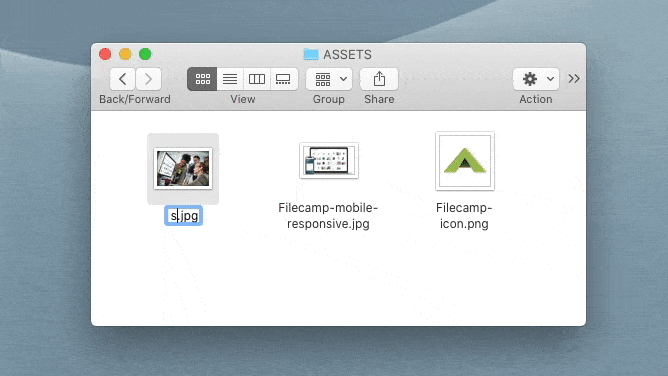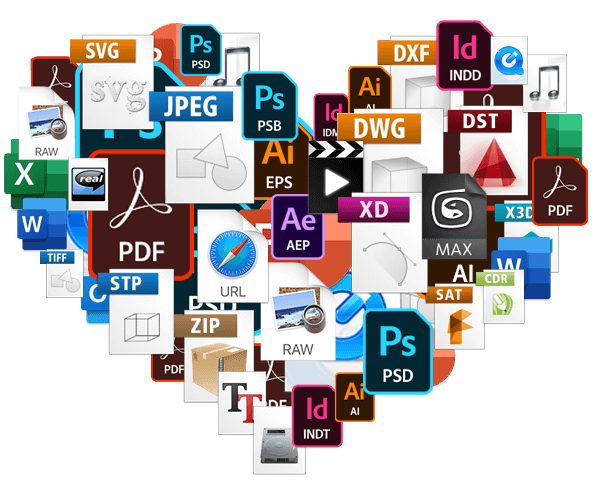How to turn your files into powerful digital assets
Graphic designers and marketers are often those people in an organization who need to go through most files and materials. Keeping them all on track and having control over every single file may not be the easiest task though, especially if file management has never previously been a priority.
Since we know how important it is to master file management, we decided to prepare a handy guide about managing files for graphic designers and marketers.
Let’s dive in!
A short story on file management in a team
Each and every person has their own rules when it comes to file management. There is nothing wrong with that - while some people love having everything structured, others are not bothered about creating an organizational mess as long as it doesn’t disturb their productivity.
Even if you have your favourite system for file management, you can always better it - and often adjust it to the overall project that you need to lead with a team.
We believe that once you spend some time working out your own way of organizing folders and naming your files, you won’t have to spend time chasing them and looking for individual files in the future.
It matters for your own peace of mind, but also for the sake of any project you’re a part of.

Why is file management important?
File management helps teams work more efficiently and without unnecessary distractions. If you manage your files in the right way, you don’t need to waste time searching for lost assets or helping anyone else to do so. No interruptions means fewer problems and more time to focus on the execution part.
Stress less
Having files all over the place instead of together in one location can indeed cause stress. Imagine a situation when you’re in need of one particular file, but you don’t even know where to start looking for it. You keep asking your colleagues, checking flash drives, and searching your e-mails, but to no avail. Not only are you wasting time but you are also not exhibiting a professional outlook, since you will appear to be an unorganized team member.
While keeping files organized doesn’t save you from all stressful situations, it will save you from a lot of the stress that can be generated by clutter.
Workflow like a breeze
Having all files in one place reduces the chance of making mistakes, helps calibrate capacity and productivity, plus it supports maintaining quality and consistency in a team - just to name a few benefits for your workflow. Since files and folders become easier to search for, working and communicating is made simpler too. Additionally, if you use digital asset management software for this purpose, your work will be centralized in one handy and accessible location.
Files and folders – how to name them correctly
What’s good for one graphic designer may not be quite right for another, but it’s sensible to work on common elements for file names. There are a few aspects to recognize here.
![]()
The most popular elements of a file name
- client’s brand name
- name of campaign
- date (back to front)
- version number
- channel of the campaign
- name of a differentiating element [image, audio, video etc]
![]()
Common mistakes with naming files
- using special characters or spaces in the name - this may negatively affect visibility and cause extra difficulties when searching. Underscores, hyphens and dashes are allowed, though.
- differing file names only via upper and lower case characters - this may also cause difficulties
- using “forbidden” words: edited, fixed, updated, new, final - they may cause confusion
- using capital letters to delimit spaces - they should rather be used to delimit words
- ordering the elements of a name randomly instead of starting from the most convenient way to retrieve the file
- including numbers as single digits (1 instead of 01, for example)
- using abbreviations that are not commonly understood
- using unnecessary repetition - it’s better to keep the name short
![]()
Should you use short file names or long file names?
Whatever you feel comfortable with. If the system you use works for you, there is no need to change it. However, if you haven’t decided on a system yet, then you may want to check out a few tips first.

Shorter names help you see the full file name quickly, but they also require you to create more project levels if you want to add more info that is not included. They may work better in an environment when the number of files is still fairly low.
Longer names include a lot of identifying details and this may help you avoid creating numerous folders in which to categorize files. Searching for long names files may therefore be easier, as they are detailed enough to be found via multiple keywords. However, since their displayed names can be abbreviated, it may not be possible to find them at first glance by looking at the name only.
Categorize files with a directory structure
Since you now know that naming files is incredibly important, it’s time to take things a few steps further - structuring your graphic and marketing projects into files and folders.
Let’s divide folders into four master types.
- WORK folder
- CLIENT folder
- PROJECT folder
- FILING folder
![]()
WORK folder
If you use your own personal computer then you need an initial step of dividing private files and work files. The easiest way to differentiate them is to…keep your work separate, in a WORK folder. From now on, anything that is work-related goes straight into that top folder.

CLIENT folders
No matter if you’re a graphic designer or a marketer, chances are that you’re responsible for tasks for a few various clients. This is why it’s always advisable to create separate folders for each client within the work folder, where it exists.

PROJECT folders
Depending on the scope of collaboration, you may be in charge of many projects and sub-projects for the same client. If you keep all of them without optimization in just a single folder, it can - and most likely will - get messy at some point. Make sure that each project for each client has its own folder.

FILING folders
You’ve done a great job of dividing your tasks into individual clients and projects already, but there’s one step more ahead of you. What are filing folders? In these, you should store specific elements of each campaign or project. While there are many filing folders that you can create, let us introduce the five most popular types of them.

- Client input - this folder includes files received directly from the client. Anything they have shared with you should be stored in this folder. By doing so, you minimize the risk of mistaking files for your own or asking your clients for materials that they have already shared with you.
- Business - this folder stores all of the business parts of a project, including arrangements or agreements.
- Assets - this folder contains parts of the final layout and anything that you need in order to deliver or keep managing, the project. It’s likely that you’d store elements such as fonts, graphics, brand books and guidelines here.
- Design - this folder consists of actual design files in many versions - drafts, overwritten versions, and new additions to existing versions. These are not the final versions of the project nor assets that are ready to be sent across to the client.
- Production - this folder gathers all of the final versions of files - presentations, layouts, designs, and more - that are ready to be sent to the client or used publicly.

File management challenges
Even if your file directory is wonderfully organized, you might still encounter some problems. The challenge is not only to solve them when they appear, but to identify them before they escalate.
The first problem may occur when you enter a new project for which the file management looks different to the advised structure or is non-existent. There’s no mountain high enough, as they say. Try to implement a new strategy for file management, use tools that could change file names in bulk, and even go as far as to create a workshop for introducing the new rules to your team.
Another problem may be a lack of time. It takes time to collect all of the e-mails, attachments and files you may have, so organizing their management won’t happen overnight but requires effort from the whole organization.
If neither of those problems are your problems, then so far so good. You may face another challenge, though: sharing.
Let’s say that you need to access a file quickly, but the person who’s responsible for it is offline - and may be for quite some time. In such cases, having a reliable program to send large files can significantly streamline the process of delivering essential assets without delays. You don’t have the file nor the possibility of accessing it before some deadline. This problem causes another one: you can’t launch a campaign.
This is why file management needs to be not only well structured and organized, but also accessible and shareable for everyone who’s involved in the project.
And this is where Filecamp comes to save the day.

How Filecamp can support file management
A lot of files + a lot of people = a lot of hassle with project management, including file management. When an organization grows, projects and files can easily stockpile. Extensive projects requiring undertakings and handovers on a regular basis need to be supported by digital asset management software such as Filecamp.
Filecamp, as a piece of digital asset management software, offers a lot of great features than just file storage. It supports assigning metadata to your library of files so the search is made simple. You can store, search and share any assets, online and from any device.
With Filecamp, you can structure your content and files as you please, but instead of doing it on your drive or internal system, you do it in the cloud - so everyone involved can be granted instant access. All of your resources in one place, not all over the place.
Filecamp can assist with more than just organizing your files. It also supports the planning stage, collaborating (since you can easily upload, download and share assets) and designing. Your company can utilize and share your digital assets on many levels. To make them more searchable, it’s possible to add keywords to images or to Auto-Tag them, using artificial intelligence to scan your images and assign keywords.
You can quickly set up a separate, customized portal for file management and file sharing. Don’t worry about permissions - you can set up folder access settings as you want, so you can easily control both file and folder access. Adding and removing team members (both your colleagues and external partners) is simple, and changing permissions can happen in a heartbeat,
To wrap-up
You can’t learn file management overnight - it takes some time, patience and, frankly speaking, determination. However, we hope that our guide will come in handy whenever you’re looking for inspiration in file management organization.
We at Filecamp are here to support you too. Let’s find out how much more you can do and how quickly you can do it with our solution, shall we?
Share this Post

